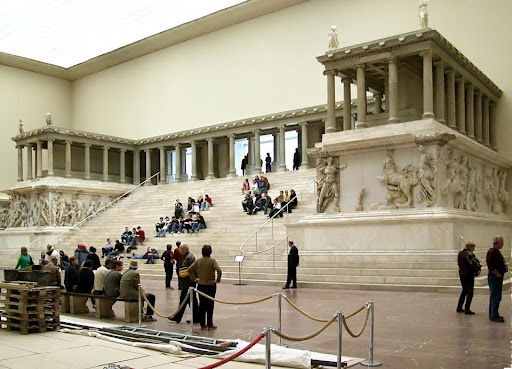
Pagan Altar/Throne from Pergamum reassembled in Germany museum
“To the angel of the church in Pergamum write:
These are the words of him who has the sharp, double-edged sword. I know where you live—where Satan has his throne. Yet you remain true to my name. You did not renounce your faith in me, not even in the days of Antipas, my faithful witness, who was put to death in your city—where Satan lives.
Nevertheless, I have a few things against you: There are some among you who hold to the teaching of Balaam, who taught Balak to entice the Israelites to sin so that they ate food sacrificed to idols and committed sexual immorality. Likewise, you also have those who hold to the teaching of the Nicolaitans. Repent therefore! Otherwise, I will soon come to you and will fight against them with the sword of my mouth.
Whoever has ears, let them hear what the Spirit says to the churches. To the one who is victorious, I will give some of the hidden manna. I will also give that person a white stone with a new name written on it, known only to the one who receives it.” Revelation 2:12-17
So as has happened with our previous churches, and the cities they reside in, it is my task to introduce you to Pergamum. Pergamum was like the Washington, D.C., of Asia. It was the seat of Roman government for the province and the center of the imperial cult. It was the first to erect a temple to Caesar Augustus (as well as to Zeus and the serpent-god Asclepius). And just like certain sectors in the church today, people in the church at Pergamum had succumbed to idolatry and were obsessed with sex (which often go hand-in-hand).
At the time, there was a large throne-like altar built on a cliff that overlooked the city. It was for the Greek god Zeus. It may be one reason John refers to the area as Satan’s throne. The throne was immediately noticeable. In the same way we associate the Arch with St.Louis, and the Space Needle with Seattle, the Throne was Pergamum’s claim to fame. Interestingly, the altar/throne was disassembled and then reassembled in the Pergamon Museum in Berlin, Germany. That is the picture accompanying this post.
While others will expand on the various sections of this text, let me share what we felt was the overall stumbling block for these churches, and that would be compromise. The Christians in Pergamum lived in a city not only where Emperor Worship was the norm, but where it was the legal expectation. Apparently, some confused Christians in Pergamum thought that they could participate in the pagan cult meals, which were an important part of social and economic life in those days. The sexual immorality that also was tolerated, if not advocated, in Pergamum may have been metaphorical, as when God’s people whore themselves out to idolatry. Jeremiah speaks of that. But, knowing man, it was probably literal as well.
In contrast to the idolatrous meals, Jesus promises manna, the food of God’s future banquet. As in the allusion to Balaam and Balak, the new exodus is never far from view: Christ is leading His people through the wilderness and will protect His remnant along the way with the sword of His mouth. Therefore, those who do not compromise themselves with idols and sexual immorality will receive a “white stone,” which acknowledges their being a new creation in Christ and admits them into the messianic feast of the kingdom.
We ourselves live in a nation, honestly a world, where sex and lasciviousness are always standing on the corner and winking at us to come on in. That is one of many ways Satan tries to lure us off the Jesus’ path. When tempted, ask the question, “What would Jesus do?” If he wouldn’t, you shouldn’t.
by Bruce Hanson (-B
Note. To access scripture links that don’t appear in the email version, read the differently formatted web version in your browser.

